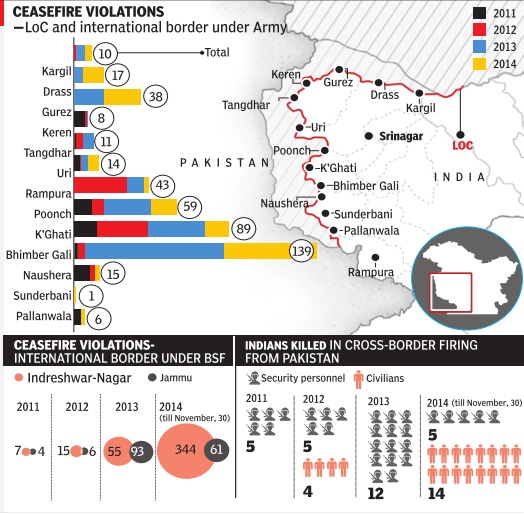Pakistan- India: Cease-fire and its violations
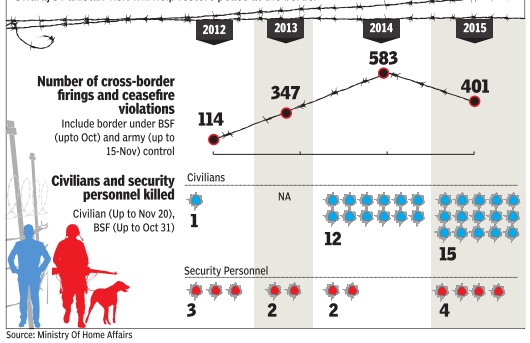
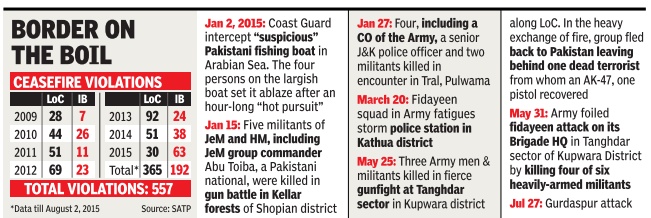
This is a collection of articles archived for the excellence of their content. |
Contents |
A brief history
2003-14
December 18, 2014
The first comprehensive ceasefire between India and Pakistan covering the international border, LoC and the Siachen Glacier was enforced on the midnight of November 25, 2003. The ceasefire was established to enable armies from both sides to perform administrative tasks along the borders.Data shows that there has been a steady increase in ceasefire violations by Pakistan in recent years.In 2011, there were 51 and 11 incidents of ceasefire violations at the border patrolled by the Army and BSF respectively. In comparison, the first 11 months of 2014 witnessed 655 ceasefire violations, 150 in areas under the Army's jurisdiction and 405 in the BSF-controlled region.Source: PIB
The Feb 2021 agreement
Indrani Bagchi, February 26, 2021: The Times of India
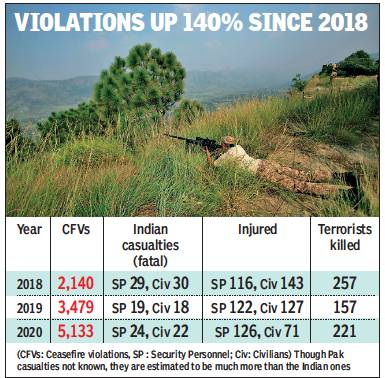
From: Indrani Bagchi, February 26, 2021: The Times of India
Ties thaw, but experts doubt ceasefire will last
New Delhi:
The call came from the Pakistani side, which set the ball rolling on the ceasefire agreement.
The first sign that some degree of softness had crept in between India and Pakistan came with a virtual meeting on Covid-19 management on February 18, where Pakistan was represented by Faisal Sultan, PM Imran Khan’s special assistant on health who, unusually, did not raise the Kashmir issue, as has been the norm with Pakistani officials.
This week, India allowed Khan’s special aircraft to fly over Indian airspace, as he travelled to Sri Lanka. In Colombo, a more mellow Khan said, “Our only dispute is Kashmir and it can only be resolved through dialogue.”
It’s too early to say whether peace is breaking out over the subcontinent but if the two sides adhere to the ceasefire, it has the limited effect of giving forces on both sides a breather. Although infiltration has come down in the past year, ceasefire violations have been fairly heavy. In recent days, Pakistani officials have also complained about civilian deaths.
The immediate goal of the ceasefire agreement is to bring down the use of heavy artillery at the LoC, and work out a method to identify civilians on either side. This is particularly hard for the Indian side, because Pakistan has been in the habit of both sending civilians to the frontline as well as infiltrating terrorists.
Former envoy to Pakistan Gautam Bambawale said, “Intentions on both sides seem positive, but we will have to see if it translates into reality on the ground.”
Pakistan analyst Sushant Sareen took a more realistic view of the development. “The ceasefire joint statement is a badly drafted document and badly timed. The high-on-verbiage document is unlikely to endure beyond this summer. Already, there are indications Pakistan is going to ramp up its export of terrorism in J&K. There are reports of magnetic bombs making an entry in the UT. These bombs have been wreaking havoc in Kabul and now could do the same in J&K. The source of this munition is of course Pakistan.”
The MEA made it clear that on key issues, India’s position has not changed. Neither has Pakistan’s. On Kashmir Day on February 5, Pakistan Army chief Qamar Bajwa, offering to extend a hand of peace in all directions, said, “Pakistan and India must also resolve the longstanding issue of Jammu and Kashmir in a dignified and peaceful manner as per the aspirations of the people of Jammu and Kashmir and bring this human tragedy to its logical conclusion.”
Border residents
Protection, 2016-18

Where India has built protective bunkers
From: February 28, 2019: The Times of India
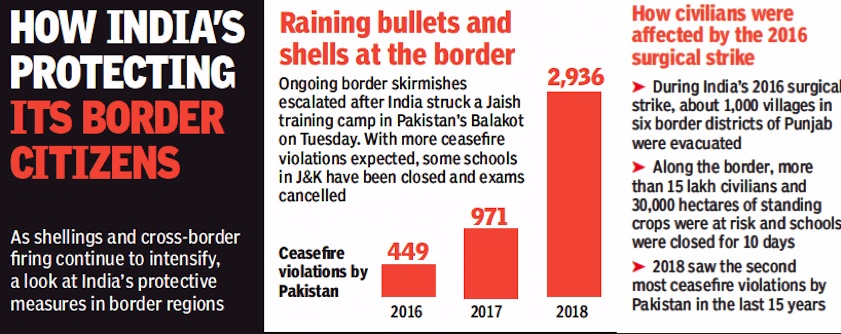
Ceasefire violations by Pakistan;
How civilians were affected by the 2016 surgical strike
From: February 28, 2019: The Times of India
See graphics:
How India protected its border residents, 2016-18;
Where India has built protective bunkers
How India protected its border residents, 2016-18;
Ceasefire violations by Pakistan;
How civilians were affected by the 2016 surgical strike
Tunnels dug by Pakistan
2012-2021
January 24, 2021: The Times of India
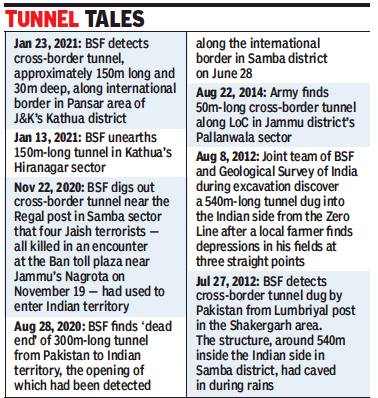
From: January 25, 2021: The Times of India
Another secret tunnel from Pak found in Jammu
Jammu:
Less than a fortnight after a cross-border tunnel used by terrorist infiltrators was unearthed in the Hiranagar sector in Jammu, the BSF detected another such underground passage around 150 metres long and three feet deep.
The secret underground route is the fourth one to be detected in the last six months along the Samba, Hiranagar and Kathua axis of the international border, reports Sanjay Khajuria.
‘10 terrorist routes dug out over past decade’
Acting on specific intelligence inputs, BSF found another tunnel in Kathua’s Pansar area early Saturday. The tunnel is located between border outposts 14 and 15,” a BSF spokesperson said.
On January 13, a 150 metre long tunnel had been unearthed at Bobiyaan village of the same sector. BSF had shot down a Pakistani hexacopter carrying weapons and ammunition in the same area last June. The other two tunnels discovered in J&K last year are in Samba. The first passage was found on August 28 and the other one on November 22. “In Jammu, 10 underground terrorist routes connecting either side of the border have been dug out over the past decade,” the spokesperson said. A joint team of BSF, Army and police busted a terrorist hideout and seized a cache of arms and ammunition in Poonch’s Hari Buddha area. The haul includes an AK-47 rifle, three AK-47 magazines, three Chinese pistols, five pistol magazines, four hand grenades, a UBGL grenade, 82 rounds of AK-47 ammunition, 33 rounds of pistol bullets and a radio set.
Violations: Jan-Nov 2014 versus 2013
Pak's truce violations up 57% over '13
Bharti Jain, Dec 04 2014
There were 545 ceasefire violations on the country's borders until November 25, marking a 57% increase over the 347 violations reported in the whole of 2013. Interestingly , the bulk of the ceasefire violations (395) this year were reported from the international border under operational control of the BSF , while the LoC and IB areas under the Army's control accounted for only 27.5% of the cases.
As per data presented in Rajya Sabha on Wednesday , the 395 violations reported from IB areas under BSF were nearly 167% more than the 148 incidents witnessed in 2013. However, the situation was reversed in LoCIB areas, with violations falling from 199 in 2013 to 150 until November 25 this year.
Though the number of security personnel martyred on account of the violations fell to five from 12 in 2013, the civilian toll rose from nil to 13.
Violations, 2013-14
Manu Pubby, Sep 8, 2014: India Today
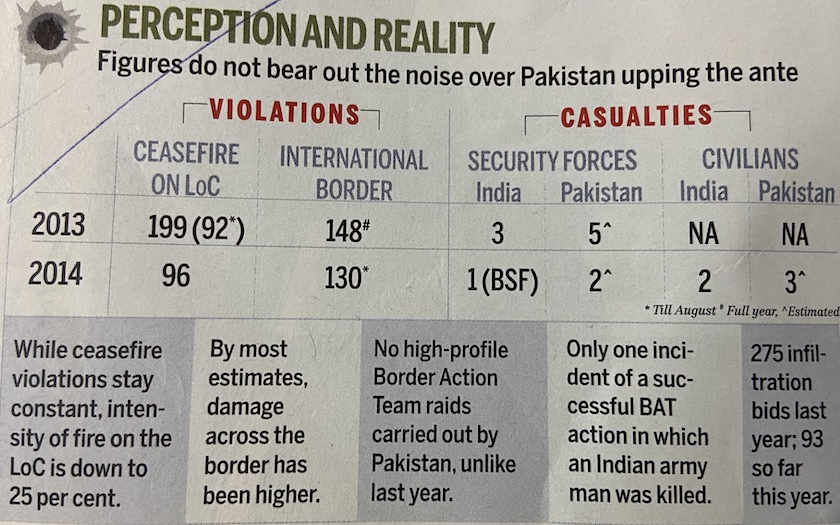
From: Manu Pubby, Sep 8, 2014: India Today
Acoordinated barrage of fire from Pakistan, targeting 50 BSF posts along the international border near Jammu, killing a jawan and creating panic leading to mass evacuation of villages. Similar heavy exchanges on the Line of Control (LoC), just falling short of heavy artillery guns being brought into action. Hundreds of mortar shells targeting a single Indian Army post to try raze it to the ground.
Sounds familiar? This was just last year, but seems a distant memory. A year on, not much seems to have changed. But the noise over "Pakistani provocations" seems higher, encouraged subtly perhaps by the official machinery and a new government keen to display its muscular policy on Pakistan months before Jammu and Kashmir elects a new state Assembly.
Contrary to popular perception, the numbers show that there is actually a slight dip in the intensity of duels this year. The contentious LoC has seen only a marginal increase in violations to 96 until August 26 compared to 92 last year. But the fatalities are down to zero this year as against two jawans last year. Significantly, the number of rounds fired or shells hurled during each violation has come down to one-fourth.
Although the prolonged period of intermittent firing on the international border since July 16 is a matter of concern, there have been nearly 130 violations so far this year compared to 148 through 2013. Going by the pattern of exchanges, the escalation has been in July-August this year and has been partially defused after flag meetings while a similar spike happened in September-October last year. While two combatants and three civilians have been killed in Pakistan, the Indian toll is two civilians and one jawan. BSF chief D.K. Pathak raised eyebrows when he claimed that such heavy cross-border firing had not been seen in "recent years ever since the 1971 war". But there is little evidence on the ground to support his claim.
While October 2013 was bad, the international border saw much higher fatalities regularly before the 2004 ceasefire pact. Government records show that in just the three-month period of January-March 2000, there were 90 firing incidents on the international border. There were 5,153 such incidents in 1998 and 2,896 incidents in 1999, the year of the Kargil conflict.
On the LoC, although the number of ceasefire violations has gone up marginally, there have been very few successful Pakistani Border Action Team raids. These raids had raised temperatures last year as seven Indian soldiers were killed in two incidents, including one in which a soldier was brutally beheaded. Similarly, there is no dramatic increase in infiltration by militants either even though the Army has been anticipating a stronger push aimed at disrupting the Assembly elections.
For instance, there were 275 infiltration attempts last year compared to 93 until August this year. Twenty-four militants are suspected to have got through this year while 95 managed to cross over in 2013. With winter setting in soon, this number is not expected to grow by too much. "Unlike last year when each exchange was strong and aimed at causing damage, the Pakistani firing this year is more for effect. Almost as if it is being done only for the sake of violating the ceasefire agreement," says an Indian Army officer.
However, what has changed this year is the Indian attitude to border management, which is encouraged by the new government in Delhi and analysts say there is need for some caution to prevent an escalation. Area commanders and military leaders have been told that they would now have a freer hand to deal with cross-border violations. Home Minister Rajnath Singh, for instance, called Pathak on August 24 amid escalating violence and gave him the go-ahead to retaliate with full force.
"Until last year, there were instructions to retaliate but there was always a sword hanging to not let the situation get out of hand. This would at times limit our response. It is different now. There is a clearer thought process that has been percolating down, that there would be no bar on retaliation," an officer of general rank told India Today.
But former generals say it also calls for equally clear thinking on the part of those with their finger on the trigger. "These kinds of events happen every year in Kashmir," says retired Lt-Gen Ata Hasnain, who was the commander of the Srinagar-based 15 Corps. "The only thing is that every year the context changes. The real reason is to ensure that the relevance of Kashmir remains in the eyes of the Pakistani public. There has, however, been a lot of exaggeration of events this year and people are more worked up. There is a lot of discussion and excitement but little informed talk on the actual situation on the border."
Cease fire violations: 2013-June 2015
The Times of India, Jul 31 2015
Since 2013, Pak violated truce 1,140 times: Parrikar
`International Border Focus Of Firing'
Pakistan has violated the ceasefire as many as 1,140 times since 2013, with the focus of its firing being concentrated more across the settled International Boundary (IB) than the Line of Control in Jammu and Kashmir. Defence minister Manohar Parrikar, in a written reply in Rajya Sabha, said while there were 347 ceasefire violations in 2013, the figure jumped to 583 in 2014.Till June 30 this year, 199 such violations have been recorded. Of the 199, only around 25 of them were across the LoC, which is manned by the Army , with the rest being along the BSFguarded IB. “Diplomatically , India has repeatedly emphasised the need for Pakistan to uphold the sanctity of the LoC and abide by the ceasefire commitment of 2003,“ said Parrikar.
After the NSA-level talks next month, the two countries are also slated to hold meetings between the BSF and Pakistan Rangers chiefs as well as the two DGMOs to discuss de-escalatory mechanisms along the borders.
Bomb hoax keeps Gurdaspur on edge
Three days after terrorists struck in Dinanagar, unidentified miscreants left a black bag with a box inside that looked like a bomb near the Gurdaspur bus stand, triggering panic in the area.Police officials said the box resembled a bomb but had no detonating device. A Punjab Armed Police bomb disposal squad, which was called in from Jalandhar, later dismantled the device.“The bag contained some wooden pieces, paper pieces and powder,“ said senior superintendent of police Gurpreet Singh Toor.
Cease fire violations: 2014-17
Rajat Pandit, February 6, 2018: The Times of India

From: Rajat Pandit, February 6, 2018: The Times of India
In the absence of any diplomatic détente, the deadly war of attrition between India and Pakistan along the 778-km Line of Control (LoC) and 198-km International Boundary (IB) in Jammu & Kashmir has taken a sharp turn for the worse ever since the “surgical strikes” of September, 2016.
There were as many as 860 ceasefire violations (CFVs) along the LoC and another 120 along the IB in 2017, the highest-ever such tally in over 15 years. The number of CFVs has already touched 241 across the LoC in the first 36 days of 2017, claiming the lives of nine Indian soldiers, as per Army statistics.
Army chief General Bipin Rawat says the Pak Army is “suffering three to four times the number of casualties compared to us” in the CFVs. Given the current mood, these long and bloody tit-for-tat fire assaults across the border, with even light artillery guns, heavy mortars and anti-tank guided missiles often coming into play from both the sides, are not going to ebb anytime soon.
A day after a young captain and three soldiers were killed in heavy shelling by Pakistani forces in Rajouri district, Army vice-chief Lt-General Sarath Chand on Monday warned of strong retaliatory action to avenge the losses. “That (retaliation) goes without saying. I think I don’t have to say that. (Our) action will speak for itself,” he said.
Added another senior officer, “Pakistan is hurt more than us…that’s why the Pak Army refuses to give its casualty figures to its own Parliament. We estimate 130-140 Pak soldiers were killed in our cross-border firings and tactical operations last year.”
But Indian soldiers have also paid a heavy price. Of the 62 who laid down their lives in J&K last year, 15 were killed in CFVs, 17 in infiltration and other incidents along the LoC and 30 in counter-terrorism operations in the hinterland.
“I don’t think the situation will get better in the short term. The atmosphere has been completely vitiated by the Pak Army strategy to send terrorists across to carry out IED blasts, mutilate our soldiers and attack garrisons. It leaves no space for any confidence-building like a ceasefire agreement,” said former Northern Army Command chief, Lt-Gen D S Hooda (retd), who oversaw the “surgical strikes” on September 29, 2016.
Indian Para-Special Forces had conducted the “surgical strikes” against terror launch pads, close to Pak Army posts, in four different locations in PoK to avenge the killing of 19 Indian soldiers in a suicide attack at the Army camp in Uri earlier that month.
That, in effect, triggered the sharp escalatory spiral, with Pakistan indulging in 78 and 88 CFVs in October and November 2016. India also began to “pro-actively dominate” the LoC with “pre-emptive and punitive fire assaults” on Pak Army posts aiding infiltration, which became all the more fiercer after two of its soldiers were beheaded in a BAT (border action team) operation in Krishna Ghati sector in Poonch on May 1 last year.
The Pak Army was obviously not about to roll over and play dead. It responded in full measure, sometimes deliberately targeting civilian centres in the Jammu region.
2015
The Times of India, Aug 12 2015
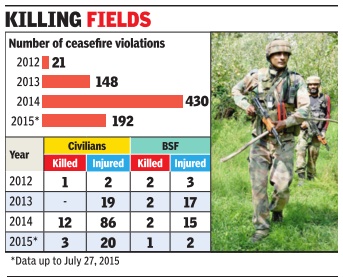

192 ceasefire violations along border in J&K this year: Govt There have been 192 ceasefire violations along the international border in Jammu and Kashmir this year until July 26, resulting in the death of three civilians and one BSF personnel. As many as 50 houses were damaged in the border firing from Pakistan, which temporarily affected 7,110 persons. Minister of state for home Haribhai Parathibhai Chaudhary , in a written reply in Lok Sabha, said the ceasefire violations in 2014 were the highest in the last four years. In the 430 ceasefire violations reported last year, 12 civilians and two BSF personnel were killed. As many as 86 civilians and 15 border personnel were injured. The heavy shelling from across Pakistan damaged 140 houses, affecting over 2 lakh people on a temporary basis.
While the ceasefire violations in 2013 were 148, the figure was just 21 in 2012.
Chaudhary said infiltrators sometimes used the cover of cross-border firing to sneak in from across Pakistan. Listing the measures taken to check ceasefire violations and ensure the safety of civilians living in border areas, the minister said proper defence preparedness includ ng strengthening of nakas, ield fortifications and highmast lights were ensured at the border. Immediate and ef ective retaliation by BSF personnel was carried out to unprovoked firing.
Mechanisms have been instituted at border outposts and border areas to expedi tiously inform villages of any occurrence of cross-border firing. BSF regularly talks to people living in villages close to the border, advising them not to move in the vicinity of areas prone to unprovoked fire without its prior information permission.
Truce breach in Rajouri, Poonch
In twin ceasefire violations, Pakistani troops on Tuesday resorted to small arms firing on forward posts along the LoC in Rajouri and Poonch districts, drawing retaliation from the Army.
“Pakistan Army had resorted to unprovoked firing across the Line of Control in Krishna Ghati Sector of Poonch district since 0100 hours,“ a defence Spokesman said. “Troops on our side of Line of Control retaliated. No casualty or damage reported,“ the spokesman added. PTI
Pakistani transgressions; July- Aug 2015
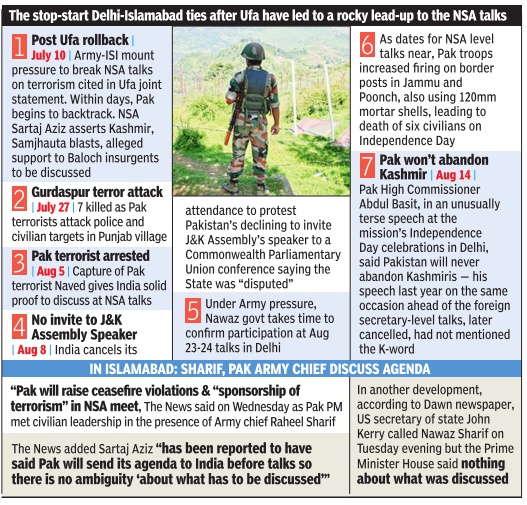
See graphic
2015-16, number of ceasefires by Pakistan
Pakistan violated ceasefire daily in 2015, 2016: MHA , May 7, 2017: The Times of India
HIGHLIGHTS
MHA said that 1,142 terror incidents were reported in J&K between 2012 and 2016 in which 236 security personnel and 90 civilians were killed.
In the same period, 507 terrorists were killed in encounters, the ministry said.
At least one incident of ceasefire violation by Pakistan has been reported daily along the LoC in Jammu and Kashmir in 2015 and 2016, with 23 security personnel being killed in the two years, the home ministry has said in an RTI reply.
It also said that 1,142 terror incidents were reported in J&K between 2012 and 2016 in which 236 security personnel and 90 civilians were killed.
In the same period, 507 terrorists were killed in encounters, the ministry said.
According to the reply, Pakistan violated the ceasefire across the Line of Control 449 times in 2016, as compared to 405 violations in 2015. Twenty-three security personnel were killed in the two-year period, it said. Major Gen (retd) G D Bakshi said Pakistan is running a "covert" war against India.
"Though Pakistan talks about peace, it does not believe in it, and Jammu and Kashmir is an example," he said.
Compared to 220 terror incidents in Jammu and Kashmir in 2012, there were 322 incidents in 2016 in which 82 security personnel and 15 civilians were killed, the RTI reply said.
It said in 2015, 39 security personnel and 17 civilians were killed in 208 terror incidents while 108 terrorists were killed in encounters. While 47 security personnel and 28 civilians were killed in the state, 110 terrorists were killed in encounters in 2014, the reply said.
The RTI reply said in 2012, 15 security personnel and as many civilians were killed in 220 terror incidents, and 72 terrorists were killed in encounters. In 2013, 53 security personnel and 15 civilians were killed in 170 terror incidents in J&K with security forces killing 67 terrorists in encounters.
"There is a new trend these days. Whenever the army surrounds militants in an area, messages are sent on social media platforms and residents from nearby places gather there, slowing down operations," Bakshi said.
2016
Jan- Oct 2016, esp. after surgical strikes
Neeraj Chauhan, Over 300 Pak firings since Sept-end, Nov 04 2016 : The Times of India
`To Seek Revenge For Surgical Strikes, It's Even Targeting Civilians'
Government officials said in Nov 2016 that Pakistani forces were deliberately targeting civilians in border areas as Islamabad was desperate for a “face-saving“ exercise following the September 29 surgical strikes by Indian troops on terror launch pads.
Officials said that Pakistan had directed its forces to target BSF, the Army and not even spare the civilians as part of their “revenge“. Pakistan's aggression is evident by the fact that two-thirds of a total of 500 ceasefire violations along the western border have taken place in the last five weeks.
In Jammu alone, 200 ceasefire violations by Pakistan have been recorded in 2016 till Oct 31, most of them since the surgical strikes. In 2015, the total number of violations recorded by Pakistan were 405.
Officials said that the BSF was currently dealing with the “troika“ of Pakistani army , Pak Rangers and terrorists who have been trying to cross into the Indian territory under the cover of cross border fire. However, the Indian forces have retaliated to the fire adequately . Many people have been displaced and over 100 schools have been closed near LoC and IB.
Faced with the massive retaliation by the BSF, the Pakistan Rangers have now started feeling the heat. Ac cording to officials, two days before Diwali, Pakistan army and Rangers targeted Indian border out posts (BoPs) at Jammu's Akhnoor sector with small arms fire and mortar shelling without any provocation.
The BSF retaliated in such a manner that Pakistan Rangers' waived white flags asking the personnel to stop the fire.Several Pakistani soldiers got killed in the retaliatory fire.BSF had decided to throw everything at the Rangers in Akhnoor, which is also called the chicken's neck due to its shape as the Pakistani territory extends into the Indian side.“As the Rangers waived white flags and called for talks, BSF stopped the fire. They (Rangers) were clearly informed that talks could happen only at the commander level,“ said an official. However, the BSF never heard from the Rangers ever since they started targeting Indian posts again.
“It is usually a trick Pakistan tries whenever it is on shaky ground. Whenever they (Pak forces) realise that they cannot outdo an Indian response, they give up and ask for peace,“ said an officer.
A home ministry official said, “Our forces neither initiate ceasefire violation nor do they target civilians. They retaliate in a very calibrated and restrained manner when either their posts or personnel are targeted or cover fire is provided by Pakistan to allow infiltrators to cross over to India.“
2017
January-September 2017, 600 violations
HIGHLIGHTS
Pakistani troops have opened fire on Indian territories more than 600 times till September 30.
Eight civilians and 16 security personnel were killed in the firing, a home ministry official said.
It is the highest number of ceasefire violations in nearly a decade, the official said.
Pakistan has violated the ceasefire over 600 times so far this year, the highest in the last one decade, an official said.
Pakistani troops have opened fire on Indian territories more than 600 times till September 30. Eight civilians and 16 security personnel were killed in the firing, a home ministry official said.
It is the highest number of ceasefire violations in nearly a decade, the official said.
The truce between India and Pakistan along the International Border, the Line of Control and the Actual Ground Position Line in Jammu and Kashmir had come into force in November 2003.
India shares a 3,323-km-long border with Pakistan of which 221 km of the IB and 740 km of the LoC fall in Jammu and Kashmir.
There were nearly 450 ceasefire violations in 2016 in which 13 civilians and as many security personnel were killed.
2017: Pak violated 881 times, killing 30
December 20, 2017: The Times of India
The government informed Parliament that Pakistan violated the ceasefire a total of 881 times along the line of control (LoC) and the international border (IB) in Jammu and Kashmir this year, killing 30 people. Minister of state for home Hansraj Ahir informed the Lok Sabha that Pakistan has violated the ceasefire along the LoC in Jammu and Kashmir 771times till December 10, and 110 times along the IB till November-end. In these incidents of firing from across the border, 30 people — 14 Army personnel, 12 civilians and four Border Security Force (BSF) personnel — were killed.
No cross-border firing has been reported in other states except Jammu and Kashmir along the border with Pakistan, he said replying to a written question. According to security forces, Pakistan has used ceasefire violation to assist infiltration of terrorists into Indian territory for past few years and it is making continuous such attempts to disturb peace in the Kashmir valley but the Army, the BSF and other security forces are responding to such violations befittingly. The BSF and the Army have conducted special operations to retaliate to Pakistani firing on several occasions and several Pak Rangers and Pak Army officials have also been killed. The ceasefire between India and Pakistan along the international border, the line of control and the actual ground position line in Jammu and Kashmir came into force in November 2003.
2017: largest ceasefire violations since 2014
2017 new high for Pak border assaults, December 24, 2017: The Times of India
The cross-border firing by Pakistan army that killed a major and three soldiers at Keri in J&K’s Rajouri sector came towards the end of a year that saw over 780 ceasefire violations by Pakistan along the 778km Line of Control and 120 along the 198km international border.
Over 33 people, including 12 civilians, have been killed in these firings.
This marks a new high in recent years. Ceasefire violations along the LoC in 2014 and 2015, for instance, stood at 153 and 152, respectively, while the tally was 228 in 2016. Army chief General Bipin Rawat recently held that peace talks with Pakistan could take place only when it stopped supporting terrorists in Jammu & Kashmir. But given its actions and behaviour, it didn’t appear that Pakistan really wanted peace, he added.
Director general of military operations Lt Gen A K Bhatt had also told his Pakistani counterpart, Major General Sahir Shamshad Mirza, that there appeared to be a “disconnect” between his army headquarters at Rawalpindi, which professes a desire for peace, and its troops on the ground along the LoC, who resort to heavy firing and ceasefire violations without any provocation.
While maintaining that the Army will continue its efforts to ensure peace and tranquillity on the borders, Lt Gen Bhatt said it will “continue to take all retaliatory measures and retain the right to punitively respond to any provocative acts of aggression from the Pakistani side”.
The Indian Army has repeatedly told the Pakistan army to desist from actively abetting cross-border terrorism and infiltration, warning that all misadventures to either target Indian troops or provide cover fire to infiltrating terrorists would be met with retaliatory punitive fire assaults. India has stressed that any collateral damage in the cross-border firings is due to the Pakistan army’s “unacceptable” support to cross-border terrorism and infiltration as well as its strategy to deploy civilians at forward posts to gain intelligence and act as guides to terrorists crossing the LoC.
2017: Indian Army kills 138 Pak soldiers in tactical ops
Army kills 138 Pak soldiers in 2017 in tactical ops, January 10, 2018: The Times of India
The Indian Army killed 138 Pakistan Army personnel in 2017 in tactical operations and retaliatory cross-border firings along the Line of Control (LoC) in Jammu and Kashmir, government intelligence sources said.
The Indian Army lost 28 soldiers during the same period along the LoC, the sources said.
The sources said the Pakistan Army usually does not acknowledge the deaths of its personnel and shows them as civilian casualties in certain cases.
The Indian Army has been adopting a "tough" approach in dealing with ceasefire violations and terrorist activities in Jammu and Kashmir in the last one year.
The Pakistan Army has suffered 138 fatal and 155 non- fatal casualties in tactical operations and retaliatory cross-border firings along the LoC in 2017, the intelligence sources told PTI.
A total of 70 Indian Army personnel were injured during cross border firings and other incidents.
Asked about the fatalities on the Pakistani side, the Army refused to comment. However, Army spokesperson Col Aman Anand said India has been effectively retaliating against all ceasefire violations by the Pakistan Army and will continue to do so.
According to official figures, 860 incidents of ceasefire violations by Pakistani troops were reported in 2017 as against 221 last year.
It seems the Pakistan Army has a policy of not acknowledging the killing of its personnel, the sources said. They also referred to the Kargil war when Pakistan had declined to accept casualties despite proof given by India.
The sources also cited an incident on December 25 when a group of five Army commandos crossed the LoC in Jammu and Kashmir and killed three Pakistani soldiers. The Pakistan Army had posted a tweet that day acknowledging the deaths but later deleted it.
The Pakistan Army's spokesperson two days later rejected reports that Indian commandos selectively targeted a post across the LoC and killed three of its soldiers.
The intelligence sources said Indian Army killed 27 Pakistani soldiers in sniper firing last year while seven of its soldiers lost their lives in Pakistani sniper firing along the LoC.
As part of its policy of "hot pursuit", the Indian Army has been carrying out tactical operations to foil Pakistan Army's support to terrorists.
In May last year, the Indian Army had said it launched "punitive fire assaults" on Pakistani positions across the LoC, inflicting "some damage", days after two Indian Army personnel were beheaded.
2018
Jan 1 –Feb 14 (with some 2017 figures)
The Army has killed around 20 Pakistani soldiers and injured several others since January 1 this year by cranking up its policy to conduct punitive fire assaults and guerilla operations along the LoC to “proactively dominate” the border, government sources asserted on Thursday.
“The Army, with all its commanding officers along the LoC being given adequate freedom of action, is hammering and bleeding the Pakistan army to deny it any tactical advantage or moral ascendancy along the border,” said a source.
The targeted military pressure being exerted on the Pakistani army along the LoC has forced it to sound 35 “red-alerts” for its border troops, even as its 10 Corps commander Lt-Gen Nadeem Raza has visited a dozen border sectors since January, said the sources.
Several Pakistani posts have been destroyed in the fire assaults, with light field guns, heavy 120mm mortars and anti-tank guided missiles also coming into regular play from both sides, in areas like Balnoi, Mendhar, Kalal, Keran, Doda, Sarla, Laleali and Banwat along the 778-km Line of Control over the last four to five months.
All this comes in the backdrop of the escalating rhetoric between India and Pakistan, with the two defence ministers warning each other’s countries of deadly retribution, as well as the scathing criticism against the Modi government by Congress and other parties for failing to deliver on all its tough talk against Pakistan.
But both Army chief General Bipin Rawat and Northern Command chief Lt-Gen Devraj Anbu have stressed that the Pakistani army “is suffering three to four times more casualties” in the heavy exchange of crossborder firings.
If India lost 32 soldiers in CFVs, infiltration and other incidents along the LoC in 2017 (another 30 laid down their lives in counter-terrorism operations in the hinterland), sources said it’s estimated that 130-140 Pakistan soldiers were killed in the same year based on “radio intercepts, intelligence inputs and other information collated from different sources”.
Jan- Feb: 400 violations in 57 days
57 days, 400 truce violations: Pak leaves Kashmir reeling, February 27, 2018: The Times of India
If Trend Continues, 2018 Will Record Highest No. Of Breaches Ever
The line of control in Jammu & Kashmir between India and Pakistan remains extremely volatile, with ceasefire violations already jumping to over 400 in the first two months of this year. Apart from civilians, Pakistan has lost 23 soldiers in the firing duels, while the tally for India is 16 till now.
If this trend continues — and it has shown no signs of ebbing as yet — then 2018 is likely to record the highest number of violations along the LoC in the 15 years since the ceasefire along the 198-km international border in J&K, the 778-km LoC and the 110-km actual ground position line in Siachen came into force as a confidence-building measure between the two countries on November 26, 2003.
The step-up in cross-border hostilities, which saw as many as 860 ceasefire violations along the LoC and another 120 along the international border in 2017, began soon after Indian para-special forces conducted “surgical strikes” against terror launchpads in four different locations in Pakistanoccupied-Kashmir to avenge the killing of 19 soldiers in a suicide attack at the Uri Army camp in September 2016.
As part of its policy to “proactively dominate” the 778-km LoC through punitive fire assaults and guerilla operations, the Indian Army has destroyed several Pakistani Army posts in areas like Balnoi, Mendhar, Kalal, Keran, Doda, Sarla, Laleali and Banwat over the last four to five months, as reported by TOI earlier.
“Pakistani army posts aiding and abetting infiltration are being targeted. As per assessments, there are almost 400 terrorists in and around launchpads, both south and north of the Pir Panjal range, waiting to infiltrate into J&K,” an officer said. With even 105mm light field guns, heavy 120mm mortars and anti-tank guided missiles being regularly used by both sides over the last few months, the latest bout of heavy shelling took place in and around Uri last week.
Though the shelling in Uri has reduced a little now, the Pakistani army earlier even used loudspeakers to warn villagers there that it was going to open fire to avenge the killings of its soldiers by the Indian Army. “The warning was probably meant for villagers in PoK to take shelter. But villagers on our side also fled the area,” said an officer.
Army officers say the residents of border villages in Balkote, Silikote, Tilawari, Thajal, Churunda, Hathlanga and Batgra were evacuated to the government school at Uri due to “the unabated targeting of the local civilian populace by the Pakistan army”.
Both Army chief General Bipin Rawat and Northern Command chief Lt-Gen Devraj Anbu have stressed that the Pakistain army “is suffering three to four times more casualties” in the heavy exchange of firings.
If India lost 32 soldiers in truce violations, infiltration and other incidents along the LoC in 2017 (another 30 laid down their lives in counterterrorism operations in the hinterland), Army sources estimate 130-140 Pakistani soldiers were killed in the same year based on radio intercepts, intelligence inputs and other information collated from different sources.
2018, Jan> mid-May, highest violations since 2003
The ongoing cross-border firing duels between India and Pakistan, with artillery guns, antitank guided missiles and heavy mortars being used by both sides, have broken all records over the last 15 years.
Latest defence ministry-Army data showed 881 ceasefire violations (CFVs) were recorded along the 778-km long Line of Control (LoC) in the first 141 days of 2018, higher than the 860 violations in 2017, which was the record.
Sources said the government may have gone for unilateral suspension of counter-insurgency operations in J&K during Ramzan but there is no move to reduce the military pressure exerted on Pakistan along the border.
Though defence minister Nirmala Sitharam on Monday did say any concrete peace overture from Pakistan would be taken seriously, sources stressed Islamabad would have to “demonstrate concrete action to stem its export of cross-border terror” for any serious de-escalation to take place.
“Any comment on wanting peace will definitely be taken seriously,” Sitharaman said on being asked about Pakistan army chief General Qamar Javed Bajwa’s recent statement that a peaceful resolution of bilateral disputes, including Kashmir, could be found through “comprehensive and meaningful dialogue.”
As for suspension of operations against terrorists in the hinterland, Sitharaman said, “We (the armed forces) shall fully honour the policy that the home ministry on behalf of the government of India announced.”
The Army reluctantly agreed to suspend operations during Ramzan because it believes similar initiatives failed in the past, with terror outfits using the intervals to regroup, re-arm and unleash further violence, as was earlier reported by TOI.
But the defence establishment is in no mood to ease its “proactive” approach to “dominate” the LoC with Pakistan, with targeted fire assaults and covert tactical operations, despite rising casualties on both sides.
“The terror factory is Pakistan is alive and kicking. Almost 30 of the 50-55 terrorists who have tried to infiltrate into India this year have been successful,” a senior officer said.
Oct 2018: India retaliates, targets Pak brigade HQ in POK
Almost a week after Pakistan shelling an old structure in the Poonch area in Jammu & Kashmir, Indian Army gave a befitting reply by targeting the Hazira Brigade headquarters of Pak army across the Line of Control (LoC) in Pak Occupied Kashmir (POK), sources said.
The revelation by sources in the Indian Army came on a day when a video went viral on social media showing explosion in an area believed to be in the PoK. The targeting of Hazira Brigade headquarters follows Pakistan army’s violation of ceasefire by lobbing a shell on an old structure of the Poonch Brigade on October 23.
No casualties were reported in the October 23 shelling which resulted in a fire. Initially, the Army had stated that the fire was not related to cross border shelling. But a defence spokesperson confirmed that Pakistani troops had fired rocket propelled grenades. “One round landed on a barrel type store shelter in Poonch causing it to catch fire,” the spokesperson had said on October 23.
The sources said on Monday, “Indian Army has given a befitting reply to Pakistan for their cowardly act of October 23.” On October 21, the Indian Army had successfully foiled an infiltration bid in Sunderbani sector of Rajouri by killing two Pakistani intruders. Three Army jawans were killed in the encounter.
Nov: India, Pakistan agree to respect 2003 ceasefire
At flag meet, India, Pakistan agree to respect 2003 ceasefire, November 24, 2018: The Times of India
India and Pakistan decided at a brigadier commander-level flag meeting on Friday to once again adhere to the 2003 ceasefire understanding between the two armies after a spurt in crossborder firing duels over the last month following a spell of relative calm.
The flag meeting between Brigadier V S Sekhon and his Pakistan army counterpart Brigadier Qaiser was held at the Poonch-Rawlakote Crossing Point in J&K at 11 am. “We told the Pak army, which had called for the flag meeting, to control its ceasefire violations, while expressing concern at the continuing infiltration attempts by terrorists across the line of control. The Pak army assured it will institute measures to maintain peace and tranquility along the LoC ,” said an officer.
2019
2019/ 21 Indians died in 2,050 ceasefire violations by Pakistan in 2019: MEA
The Ministry of External Affairs (MEA) on Sunday said that the Pakistani Army resorted to a total of 2,050 unprovoked ceasefire violations in 2019 in which, the ministry said, 21 Indians lost their lives. The ministry also said that the Indian government has highlighted the concerns of "unprovoked ceasefire violations," "cross border terrorist infiltration", and "targeting of Indian civilians".
The Indian government has also called upon the Pakistani administration to adhere to the 2003 "ceasefire understanding, maintain peace and tranquility along LoC and the International border".
"Highlighted our concerns at unprovoked ceasefire violations by Pakistan, including in support of cross border terrorist infiltration and targeting of Indian civilians and border posts. This year, they resorted to over 2050 unprovoked ceasefire violations in which 21 Indians died," the MEA said.
It added: "We've repeatedly called upon Pak to ask its forces to adhere to 2003 ceasefire understanding and maintain peace and tranquility along LoC and the International border. Indian forces exercise maximum restraint and respond to unprovoked violations and attempts at cross border terrorist infiltration."
On Saturday, the Pakistani troops engaged in heavy firing and mortar shelling on the forward posts and villages along the Line of Control (LoC) in Poonch district of Jammu and Kashmir on Saturday in violation of the ceasefire, officials said.
The firing and mortar shelling from across the border started in Balakote and Mankote areas around 10 am, drawing strong retaliation from the Indian Army, the officials said.
Balakot air strike killed 130 170: Italian journalist
May 9, 2019: The Times of India
Balakot air strike killed 130-170: Italian reporter
Around 45 people are still undergoing medical treatment following the Indian Air Force strikes on the Jaish-e-Muhammed terror training camp in Pakistan's Balakot, while the bombings could have killed 130-170 JeM cadres, including 11 terror "trainers", according to Italian journalist Francesca Marino.
Marino says in her report that despite Pakistan's efforts to deceive the world, details of what happened at Balakot in the early hours of February 26 have trickled in. She said that according to a source, a Pakistan Army unit from Shinkiari reached the location at 6am, two-and-a-half hours after the strikes. "Shinkiari is around 20km from Balakot, and the (Pakistan) army unit would have taken around 35-40 minutes to reach the location from where the climb to the camp begins. Incidentally, Shinkiari is also a base of the Pakistan army, with the Junior Leaders Academy (JLA) located there," Italian journalist Francesca Marino said, writing for online magazine Stringer Asia. Marino claims that the injured were taken to a Harkat-ul-Mujahideen camp at Shinkiari and treated by Pakistan army doctors.
"Local sources say around 45 persons are still undergoing treatment in this camp, while around 20 have died during treatment due to serious injuries. Those who have recovered are still in custody of the army and have not been discharged."
She said that information from her contacts indicated the strike immediately killed a large number of Jaish-e-Muhammed (JeM) cadres. "The numbers estimated have ranged from 130-170, including those who have died during treatment. Those killed included 11 trainers, ranging from bomb makers to those imparting weapons training."
While the casualty figure at Balakot has been subject to heated speculation, Pakistan army has so far refused access to the Jaish complex to any one. Some journalists have been taken to vicinity of the strikes but no one has been able to interview those who were at the camp or continue to be there.
"Two of the trainers were from Afghanistan. To prevent news on fatalities leaking through statements of family members of cadres, a group of JeM members also visited the families of those killed and handed over cash compensation to them," she wrote.
Marino has written that adjacent to the Blue Pine Hotel, located at the foothill from where the trek to the JeM camp begins, is a painted signboard indicating presence of the Taleem-ul-Quran on the hilltop. "Unlike the earlier board, all links to JeM leader and now internationally proscribed terrorist Masood Azhar has been removed. The camp area is still under the control of the army, with a Captain rank officer of the Mujahid battalion in command."
Access to the dust track to the camp is restricted, even to local police. Apart from a few children and 3-4 teachers, the complex has been cleared of any traces of it being a JeM camp.
"Meanwhile, inhabitants of Bisian township, near the JeM camp, still speak of some locals having noticed vehicles dumping rubble in the Kunhar river during the first night after the strike.”
Pakistani casualties
January , 2021: The Times of India
Pak ex-diplomat admits 300 were killed in Balakot strike
In an embarrassing development for Pakistan, former diplomat Agha Hilaly admitted on a TV show that 300 terrorists had died in the Balakot air strike on February 26, 2019. The admission by Hilaly, who regularly takes the Pakistan Army’s side in TV debates, goes against the zero casualties claim made by Islamabad at the time of the Balakot strike.
“India crossed the international border and did an act of war in which at least 300 were reported dead. Our target was different from theirs. We targeted their high command. That was our legitimate target because they are men of the military...,” said Hilaly, speaking during a debate on a Pakistani Urdu channel. ANI
2020
October 22, 2020: The Times of India
Pakistan resorted to 3,800 ceasefire violations along LoC this year: MEA
NEW DELHI: Pakistani troops have resorted to more than 3,800 incidents of unprovoked ceasefire violations along the Line of Control (LoC) in Jammu and Kashmir this year and even supported smuggling of arms and narcotic substances, including through drones and quadcopters, the Ministry of External Affairs (MEA) said on Thursday.
MEA Spokesperson Anurag Srivastava said Pakistani forces have continued to engage in unprovoked ceasefire violations, often from civilian areas, to support infiltration of terrorists across the LoC. "This is a clear violation of the 2003 ceasefire understanding between the two sides. This year, till date, Pakistani forces have carried out more than 3,800 unprovoked ceasefire violations," he said at a media briefing.
The MEA spokesperson said there have also been attempts to drop arms and ammunition close to the LoC in the garb of civilian activities.
"We have also witnessed that Pakistan's aid and abetment to cross-border terrorism, smuggling of arms and narcotic substances have spilled over to the International Boundary including through usage of drones and quadcopters," he said.
Srivastava said such violations are regularly highlighted to Pakistan through diplomatic channels and at the regular DGMO- (Director General of Military Operations) level talks.
Asked about the possibility of the Financial Action Task Force (FATF) blacklisting Pakistan for failing to check terror financing, Srivastava said the global anti-terror watchdog has laid out standards and procedures for such action.
"It is understood that Pakistan has addressed only 21 action items so far out of the total 27 points in the FATF action plan. Six important action items are yet to be addressed," he said.
"As is well known, Pakistan continues to provide safe havens to terrorist entities and individuals and has also not yet taken any action against several terrorist entities and individuals including those proscribed by the UNSC such as Masood Azhar, Dawood Ibrahim, Zakir-ur-Rahman Lakhvi etc," Srivastava added.
The FATF began its three-day virtual plenary meeting on Wednesday.
The FATF had put Pakistan on its "grey list" in 2018 for failing to contain terror financing in the country. The global body has been periodically reviewing the implementation of the action plan it had recommended to Pakistan to curb financial activities of terror groups.
Notwithstanding the coronavirus pandemic in the region, Pakistan has been resorting to unprovoked ceasefire violations along the LoC and making concerted efforts to push militants into Kashmir.
Pakistani hostilities increased after India announced its decision to withdraw the special status of Jammu and Kashmir and divide the state into two union territories in August last year.
See also
Pakistan- India economic relations
Pakistan- India: Cease-fire and its violations
Nuclear weapons testing: India- Pakistan
Nuclear arsenals: India, Pakistan
and many more articles, especially about the 1965 and 1971 wars, The Kargil war of 1999, 1947...
